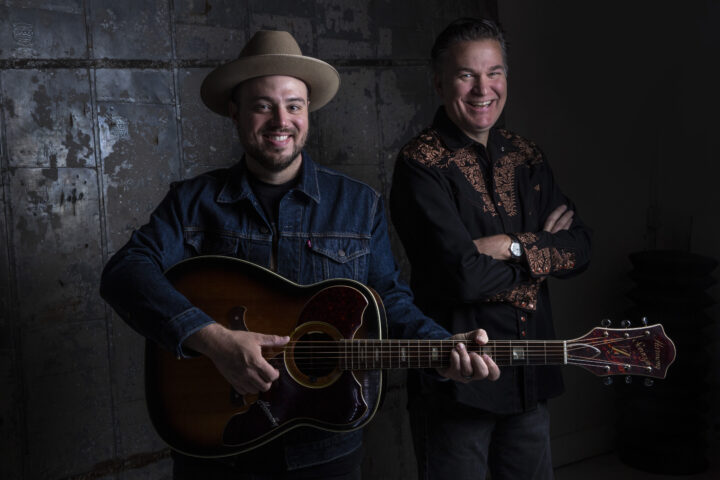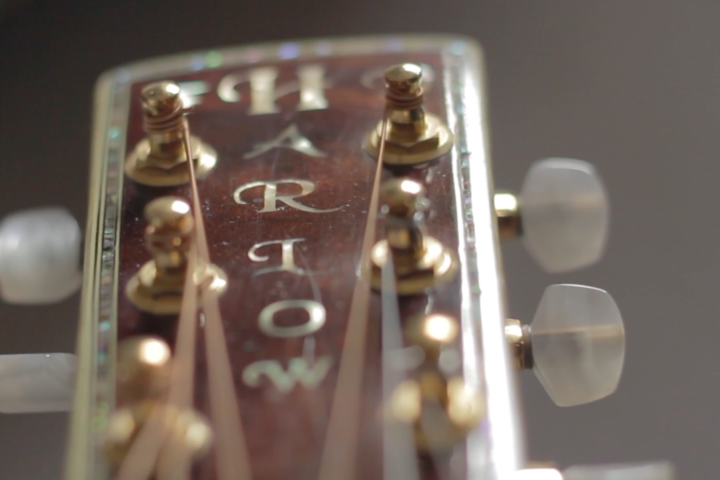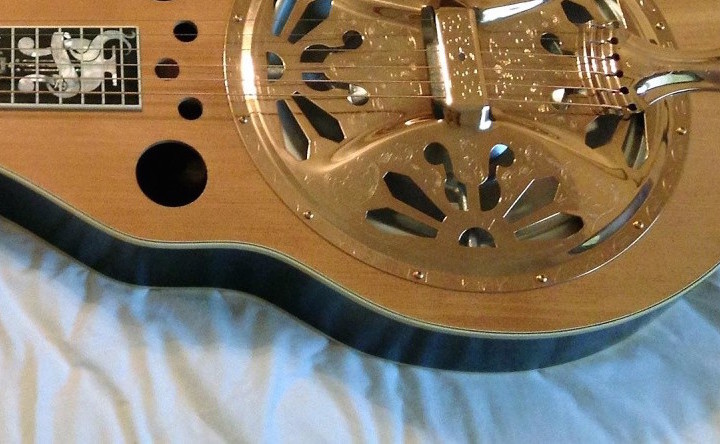Although he added new and unpredictable sonic dimensions to recordings and live performances by King Crimson, Frank Zappa, David Bowie, Talking Heads and Paul Simon’s Graceland, Adrian Belew’s 1986 solo album, Desire Caught By The Tail unceremoniously slipped under the radar and soon fell out of print. Most folks wrote it off as “weird” or “experimental,” as the project, unlike his first two earlier releases, Lone Rhino (1982) and Twang Bar King (1983), was not song-based, but offered eight instrumental pieces for guitar and percussion, all played by Belew. A proficient drummer and six-string innovator who stretched the vocabulary of the guitar, Belew had proven himself as an evocative vocalist and poetic lyricist as King Crimson’s front man. Employing layers of sound with his guitar synth, an open-tuned dobro and various percussion, Adrian was on a mission to stretch heads on his third solo release. Belew began recording the album at Royal Recorders, in Lake Geneva, Wisconsin in 1985, shortly after the demise of King Crimson. “I cut it along with just an engineer,” he explained in an interview in May 1987. “I got very wound up in it and felt like I was baring my soul. I loved what I was doing.”
While “Edgard Varese and the Beatles had the biggest effect on [his] life,” Adrian pays homage to Picasso with Desire Caught By The Tail. The record’s evocative title was borrowed from an absurdist play (Le Désir attrapé par la queue) written by Pablo Picasso in 1941, following the German occupation of Paris. Due to the chaos of war, the play was not performed for another three years was not until 1944 when it was directed by Albert Camus, by a cast that included Simone de Beauvoir and Jean-Paul Sartre, along with the famous artist himself. Along with the album’s Picasso-influenced cover art by his ex-wife Margaret, Adrian titled one track after the great Spanish painter’s famous anti-war mural “Guernica.”
This previously unpublished interview took place in the late 1980s in Lake Geneva, where Adrian was living in an old large Victorian house following his recent split up with Margaret. Belew, as we know from his song lyrics, was deeply inspired by the sounds of nature, which he also replicated stunningly with his textural guitar synthesizer. Rhinos, blue whales, electric cats and tangoing zebras all thrived within his creative realm. Why then would I have been surprised as a dozen or so small grey birds with red beaks sang mellifluously, while fluttering about freely inside the house as we spoke? It was just another day in the life of this brilliant eccentric.
John Kruth: Is this Dobro your only acoustic guitar?
Adrian Belew: No. I have a classical acoustic guitar which I keep in the attic, which is a big wide-open space where I can go sit in quiet when I want to write on a normally-tuned guitar. It’s a nylon string that I usually keep tuned normally. It’s odd to walk into my place to find a guitar that isn’t tuned in some strange tuning. I get comments from guitarists all the time who just happen to pick up one of my guitars and say, “What the heck is this?”
JK: How did you get into the Dobro?
AB: The Dobro is my favorite acoustic instrument because it brings out a whole different side of my writing. That’s because I use a different tuning. It reminds me of a piano when I play it.
JK: Do you play it on your lap or hold it like a guitar?
AB: I play it like a guitar. I’ve never played slide on it at all. From the very day I got it I started tuning it to an open tuning, which is all E’s and B’s. I don’t know if it has a name. It’s EBEEBE either way you look at it. So in the middle of the Dobro you basically have two E’s. One because it’s a G string is very flaccid and the other is tight and wound. You get an interesting chorusing out of it, plus having the flaccid G string you can play a lot of microtonal sounding things. Then I discovered that the instrument actually resonates better in Eb. So I started pitching it all in Eb and Bb. After you play it for a while, you find all the different chord shapes that might work. It can be so inspiring! The first half of Desire Caught By The Tail was written that way.
JK: That tuning sounds like it would be good for playing in a modal style or for Indian ragas.
AB: It does two things for me. It does bring out that interest, but it also makes me imagine I can write like George Gershwin, which is, of course, ridiculous! Maybe it’s the metal body. There’s a certain reverberation that comes off metal-bodied guitars that reminds me of the sound and style on those old records. That’s why the first thing I wrote on it was “Tango Zebra” (from Desire Caught By The Tail).
JK: Do you find yourself playing up and down the neck in this tuning or more out of chord formations?
AB: I tend to play up and down and then I find different chord shapes that work. There are probably about half a dozen of them that have become my vocabulary. With that I can really write a lot of different kinds of things that all fit together real well.
JK: Do you put a pick-up on it?
AB: Yeah, a Barcus-Berry percussion pick-up. I frequently play it as a drum with soft mallets. All the drums on “Tango Zebra” are actually the Dobro. We varied the speed of the tape to make it sound larger or smaller. The little bridge piece also makes a really good snare drum.
JK: What connection do you find between playing the guitar and drums?
AB: They’re inseparable. I was a drummer long before I was a guitarist. It’s affected my playing very much. I frequently play guitar as a percussion instrument! I learned how to play in odd time signatures from King Crimson and Frank Zappa. Then rhythm became a whole new open field and not so much just beat. It’s so ingrained in everything I do, more than the average guitarist who doesn’t have that percussion background.
JK: I’m surprised you never play slide on it. It would seem only natural as you use it all over the neck on your electric.
AB: Yeah, I play electric that way, if I want to make the sound of a seagull or something. I strictly use the dobro as a totally different instrument. For me, it’s like a piano or something.
JK: Most people try to sound like Robert Johnson or Peetie Wheatstraw, or if they’re playing it on their lap like Jerry Douglas or Norman Blake.
AB: I like those styles of playing, but they’re not mine. I always liked the sound of a Dobro. When I got it I was thrilled but I immediately found I had a totally different response to it. It sounded like a strange piano to me, so I started treating it as such.
JK: Do you have any other ideas for the Dobro you haven’t tried out yet?
AB: This instrument has brought out a totally different side of music for me. I’d like to get another Dobro and make it fretless and use it as a Middle Eastern-type instrument and find a tuning for that. I really think that could sound great!
Photo: John Kruth


